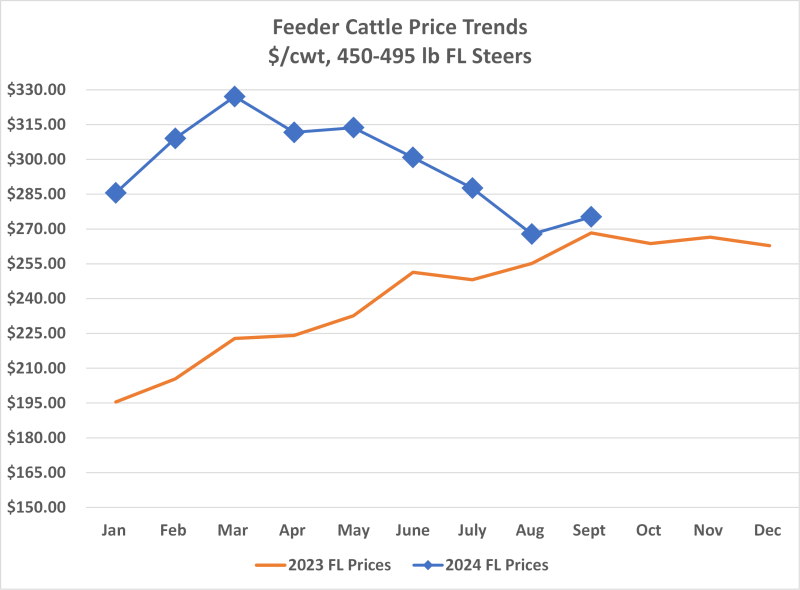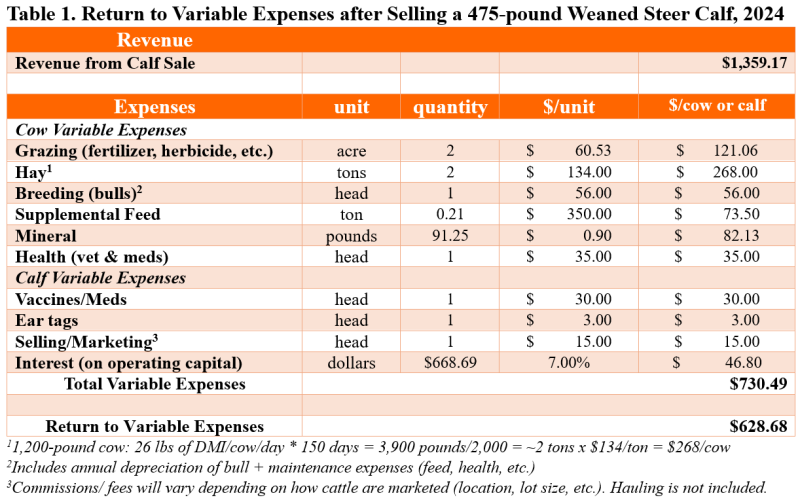I recently had a rancher ask me about whether it was more economical to background a group of steers through the winter months to sell in the spring, or sell them at weaning before the end of the year. This decision involves many factors that vary across each operation, such as feed costs, labor, available space, time, etc., with feed costs more than likely being the biggest financial factor. This is a valid question for many producers this time of year, especially this year with the current state of the market. We experienced an earlier than expected seasonal dip in prices in late summer and early fall this year but are now seeing prices for feeder cattle increase. According to the Florida Weekly Livestock Auction Summary Reports for November, the average price for a 450-495-pound steer was $286.14/cwt, up 7% compared to the same week last year (about $20/cwt).
Selling a 475-pound weaned steer calf in November would have resulted in a sale price of about $1,359.17. Now we have to consider the costs associated with getting that calf to weaning and on the trailer. Again, these costs will vary across operations, so this is just a guide based on created assumptions. Producers should carefully consider their own costs when evaluating the return from selling weaned calves. The costs for raising a weaned steer calf in this example include variable costs from breeding all the way to weaning for a spring calving operation.
According to the estimates in Table 1, it would cost roughly $730.49 per cow-calf pair from the time of breeding until weaning. Knowing the sale price of about $1,300, we can estimate the return to variable expenses to be $628.68 per calf. It is important to note that fixed costs are not included, such as depreciation, taxes, labor, and land/rent, because they range widely across operations. Nevertheless, it is always important to consider them when putting together financial estimates. So, it must be considered that this is not the “true” return. This number, however, can still be used to visualize what all is going into getting that calf to weaning and to make decisions such as holding that steer calf until spring rather than selling in the fall. Let’s take a look at that scenario.
Assuming the 475-pound steer calf will gain 2.2 pounds per day from November to March (150 days), we can assume he will weigh about 800 pounds in the spring. As of November 19th, 2024, March 2025 CME© feeder cattle futures are trading around $249/cwt. Combined with an estimated -$12 basis, the cash price for an 800-pound feeder steer in March 2025 could be around $237/cwt or $1,900 per head (based on the average basis in Georgia from 2019-2023; cash price – futures price = basis). This is in no way a concrete estimate as local markets are volatile with multiple factors affecting the basis calculation such as quality of cattle, lot size, location, and more. But for this example, this is the assumed basis and cash price based on current futures prices for March 2025.
Table 2 includes the additional costs for deciding to background the steer from November to March. These estimates should also only be used as a guide as each operation will have its own established programs that will vary in terms of expense. As a reminder, fixed costs are not included. The below estimates are for vet/meds, mineral, death loss, selling/marketing, and feeding hay and supplemental feed. Other options for backgrounding can include grazing winter annuals on farmland, stockpiled forage, or using dry lots with supplementation. The supplement should be adjusted accordingly as the calves adapt to a new environment after weaning. For this example, we assume an average supplemental feeding rate of 1.5% of body weight over the course of 150 days in addition to hay at 2% of body weight.
After estimating the additional costs, variable expenses for raising and backgrounding the steer total to $1,179.09 ($730,49 + $448.60). Both options can now be compared based on their respective returns to variable expenses. Table 3 shows that even though an additional $448 was incurred by deciding to hold on to the steers until spring, marketing the 800-pound feeder calf resulted in a higher return compared to the 475-pound weaned calf.
The takeaway from this article is not that every producer should hold their calves for 150 days . The market can be very volatile, and has been over the last year, so this decision is influenced by numerous factors. We can assume prices will increase going into the spring months for all feeder cattle, based on historical seasonality trends. But we can never be certain of what will happen in the future. You also have to think about cash flow, and how this decision could affect your income and income taxes each year. The key takeaway point is that making managerial decisions, such as when to sell a calf crop should not be made lightly. They require penciling out the estimated costs and returns and making a wise risk management decision from those conclusions that best benefit the success and profitability of an operation.
- October 2025 Florida Cattle Market Update - November 7, 2025
- Florida Calves in the Feedlot: What Extension Agents Learned in West Texas - October 10, 2025
- September 2025 Florida Cattle Market Update - October 3, 2025




